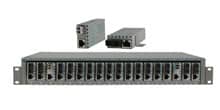- Products
- PoE Media Converters and Switches
- Ethernet & PoE Switches Product Selector
- Multi-Gigabit Ethernet and PoE Switches
- PoE PSE Commercial Switches
- PoE PSE Industrial Fiber Switches
- PoE Industrial Copper Extenders
- PoE Powered Media Converters
- PoE PSE Media Converters
- PoE Extenders & Injectors Product Selector
- Pluggable Transceivers Product Selector
- Product Lines

- iConverter Managed Multi-service Platform
- Copper to Fiber Media Converters
- Ethernet Media Converters
- 10 Gigabit Copper-to-Fiber
- 10/100/1000 Copper to 10 Gigabit Fiber
- 10/100/1000 Copper-to-Fiber with Integrated Management
- 10/100/1000 Industrial Copper-to-Fiber with Integrated Management
- 10/100/1000 Copper-to-Fiber with VLAN
- 10/100/1000 Dual Media Converter with VLAN
- Gigabit Copper-to-Fiber
- 10/100 Copper-to-Fiber with Integrated Management
- 10/100 Industrial Copper-to-Fiber with Integrated Management
- 10/100 Copper-to-Fiber with VLAN
- 10/100 Copper-to-Fiber
- Fast Ethernet Copper-to-Fiber
- Fast Ethernet Redundant Links
- 10Mbps Copper-to-Fiber
- 10Mbps Copper to Coax
- TDM Media Converters
- Serial Media Converters
- Ethernet Media Converters
- Fiber to Fiber Media Converters
- 10 Gigabit Fiber-to-Fiber Converter and Transponder
- 10 Gigabit Industrial Converter and Transponder
- SFP-to-SFP Fiber Converter and Transponder
- SFP-to-SFP Industrial Fiber Converter and Transponder
- Gigabit Fiber to-Fiber with 3 Rs
- 100/1000 Fiber-to-Fiber with 3 Rs
- Gigabit Fiber-to-Fiber
- Fast Ethernet Fiber-to-Fiber with 3 Rs
- Fast Ethernet Fiber-to-Fiber
- OC-3/STM-1 Fiber-to-Fiber
- OC-12/STM-4 Fiber-to-Fiber
- Carrier Ethernet Network Interface Devices
- CE 2.0 - 10G Demarcation NID
- CE 2.0 - 10G Demarcation and Aggregation NID
- CE 2.0 - 10/100/1000 Mult-port NID
- CE 2.0 - 10/100/1000 Mult-port NID with PoE
- CE 2.0 - 10/100/1000 8-Port NID
- SFP NID - Gigabit SFP NID
- microNID - 100/1000 compact NID
- CE 1.0 Service OAM - 10/100/1000 NID
- CE 1.0 Link OAM - 10/100/1000 Copper-to-Fiber NID
- CE 1.0 Link OAM - 10/100 Copper-to-Fiber NID
- CE 1.0 Link OAM - Gigabit Fiber-to-Fiber NID
- CE 1.0 Link OAM - Fast Ethernet Fiber-to-Fiber NID
- CWDM Multiplexers
- T1/E1 Multiplexers
- Ethernet Switch Modules
- Management System
- Chassis Options

- 1-Module Industrial Chassis

- RuggedNet Industrial Switches and Extenders
- Industrial PoE PSE Fiber Switches
- Multi-Gigabit Managed Industrial PoE+/BT Switches
- Multi-Gigabit Unmanaged Industrial PoE+/BT Switches
- 10G Managed 802.3bt PoE Switches
- 10G Unmanaged 802.3bt PoE Switches
- 10G Managed PoE+ Switches
- 10G Unmanaged PoE+ Switches
- 1G Managed PoE+ Switches
- 1G Unmanaged PoE+ Switches
- 1G Unmanaged 802.3bt PoE Switches
- 1G Managed 802.3bt PoE Switches
- Industrial Ethernet Switches
- Industrial PoE Copper Extenders
- Industrial Power Supplies

- OmniConverter Media Converter, Switches and Extenders
- PoE PSE Media Converters
- 10G Multi-Gigabit / Multi-Rate PoE Media Converter
- 10G Multi-Gigabit / Multi-Rate Media Converter
- 10/100 Multi-port PoE+ Media Converter
- 10/100 PoE+ Media Converter
- 10/100/1000 Multi-Port PoE+ Media Converter
- Industrial 10/100/1000 Multi-Port PoE+ Media Converter
- 10/100/1000 PoE+ Media Converter
- 10/100/1000 PoE++ 60W-100W Media Converter
- Industrial 10/100 Multi-port PoE+ Media Converter
- 1U Rack-Mount Shelf
- PoE PSE Compact Switches
- Multi-Gigabit Managed PoE+/BT Switches
- Multi-Gigabit Unmanaged PoE+/BT Switches
- 10G Managed 802.3bt PoE Switches
- 10G Unmanaged 802.3bt PoE Switches
- 10G Managed PoE+ Switches
- 10G Unmanaged PoE+ Switches
- 1G Managed PoE+ Switches
- 1G Unmanaged PoE+ Switches
- 1G Managed 802.3bt PoE Switches
- 1G Unmanaged 802.3bt PoE Switches
- Ethernet Switches
- PoE Copper Extenders
- Single Pair Ethernet Converters
- PoE Injectors

- miConverter Unmanaged Miniature Media Converters
- 10/100/1000 Copper-to-Fiber
- Industrial 10/100/1000 Copper-to-Fiber
- 10/100/1000 Ultra-Compact Copper-to-Fiber
- Gigabit Copper-to-Fiber
- 10/100/1000 Copper-to-Fiber PoE Powered
- 10/100 Copper-to-Fiber
- 10/100 Ultra-Compact Copper-to-Fiber
- 10/100 Copper-to-Fiber PoE Powered
- 18-Module Chassis
- Industrial 10/100 Copper-to-Fiber PoE Powered

- FlexSwitch Compact Switches
- Solutions
- Company
- Support
- How to Buy
Cybersecurity Threats in Industrial Networks and How to Mitigate Them

The backbone of modern industrial operations is industrial networks, also known as Operational Technology (OT) networks. They control and monitor critical infrastructure, from power plants and manufacturing facilities to water treatment systems and transportation networks. Unfortunately, cybercriminals are increasingly targeting these networks, posing a significant risk to safety, security, and operational continuity.
In this blog, Omnitron Systems will explore the common cyber security threats facing industrial networks and provide actionable strategies to mitigate them.
Why Are Industrial Networks at Risk?
Industrial networks are at risk due to several factors:
- Legacy Systems: Many industrial systems run on outdated technology that needs modern security features.
- Increased Connectivity: Integrating industrial networks with IT systems and the Internet has opened new attack vectors.
- Complexity and Scale: Industrial networks' vast and complex nature makes them difficult to secure.
- High-Value Targets: Industrial networks control critical infrastructure, making them attractive targets for cybercriminals.
Common Cybersecurity Threats in Industrial Networks
Unauthorized Access:
Hackers can gain unauthorized access to industrial networks through various methods, including phishing attacks, malware infections, and exploiting software vulnerabilities. Once inside, they can steal sensitive data, disrupt operations, or cause physical damage.
Malware:
Malicious software, such as ransomware and worms, can cripple industrial control systems (ICS) by encrypting critical data, manipulating processes, or causing widespread outages.
Insider Threats:
Disgruntled employees, contractors, or even business partners with legitimate access can pose a significant threat. They may steal data, sabotage systems, or sell access to cyber criminals.
Denial-of-Service (DoS) Attacks:
These attacks overwhelm a network with traffic, making it inaccessible to legitimate users and potentially disrupting critical operations.
Legacy Systems:
Many industrial facilities still rely on outdated control systems that lack adequate security features, making them vulnerable to modern cyberattacks.
Mitigating Cybersecurity Threats in Industrial Networks
Network Segmentation:
Isolate critical systems from non-critical networks and the Internet. By doing this, the attack surface is reduced and the network is shielded from attackers' lateral movement.
Access Controls:
Apply the least privilege concept to limit access to OT systems by implementing strong access controls. Use multi-factor authentication and regularly review user permissions.
Patch Management:
Regularly update software and firmware on all network devices, including industrial control systems, to address known vulnerabilities. Prioritize patching critical security updates promptly.
Security Awareness Training:
Educate staff members on cybersecurity best practices, such as identifying phishing attempts, using strong passwords, and reporting suspicious activity.
Cybersecurity Assessments:
Carry out routine evaluations of cybersecurity to identify vulnerabilities in your network and implement corrective measures before attackers exploit them.
Network Monitoring:
Monitor your network activity for suspicious behavior and implement tools to detect and prevent intrusions.
Data Backups:
Regularly backup critical data to ensure you can recover information in case of a cyberattack.
Incident Response Plan:
Develop an incident response strategy that outlines how to identify, contain, and recover from a cyberattack.
FAQs
What is the most common cybersecurity threat in industrial networks?
The most common threat in industrial networks is malware, particularly ransomware. Malware can infiltrate systems, disrupt operations, and cause substantial financial damage. Ransomware specifically encrypts critical data and demands ransom for its release, crippling industrial processes.
How can I protect my industrial network from phishing attacks?
Protecting against phishing attacks involves training employees to recognize and avoid phishing attempts. It's also critical to put strong email security measures in place, like spam filters and email authentication methods. Regularly updating and reinforcing these measures can reduce the risk of successful phishing attacks.
Why is network segmentation important in industrial cybersecurity?
Network segmentation is important because it limits the spread of malware and restricts unauthorized access within the network. Potential threats are easier to contain when the network is divided into smaller, isolated segments. This practice enhances overall network security and makes it more challenging for attackers to move laterally across the network. Network isolation and sementation can be achieved with advance features like Dual Device Mode and VLANs.
What is an Advanced Persistent Threat (APT)?
An Advanced Persistent Threat (APT) is a sophisticated and prolonged cyberattack that aims to steal data or disrupt operations. Well-funded and skilled adversaries typically carry out these attacks, often targeting specific organizations. APTs involve continuous, clandestine activities that can remain undetected for extended periods.
How often should I conduct security audits for my industrial network?
Security audits for industrial networks should be conducted annually to identify and address vulnerabilities. Frequent audits contribute to ensuring that security protocols are current and effective against new threats. In addition to annual audits, periodic reviews following significant changes in the network or after major security incidents are also recommended.
Omnitron: Your Partner in Industrial Cybersecurity
Implementing these strategies and partnering with Omnitron Systems can significantly improve the cybersecurity posture of your industrial network. Omnitron offers a range of secure industrial networking solutions incorporating robust security features to help you safeguard your critical infrastructure.
Contact Omnitron Systems today to discuss your cybersecurity requirements and find out how our products may assist you in creating an industrial network that is more resilient and safe.









